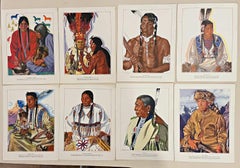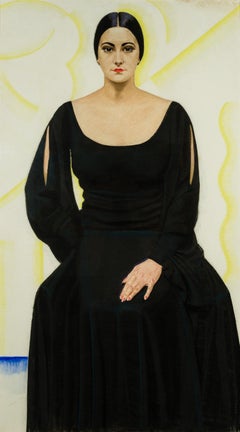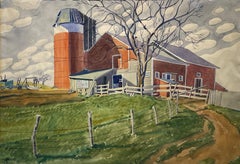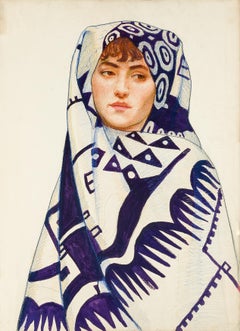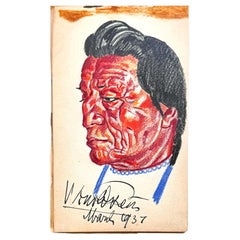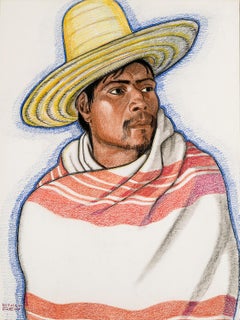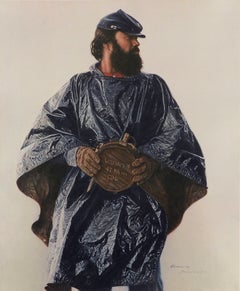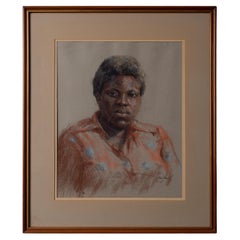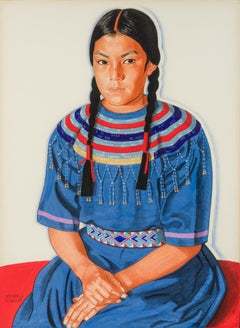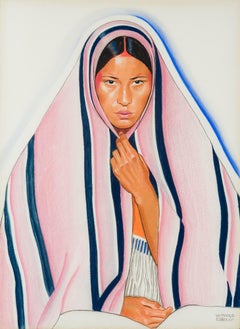Winold Reiss Art
American, 1886-1953
Winold Reiss was a German-American muralist and illustrator who is best remembered for his portraits of the Blackfoot Indian tribe. His work was so revered by the tribe that when he died, his ashes were spread across sacred burial grounds.
to
1
12
12
3
3
2
1
Blackfeet Indians, Great Northern Railway 14 prints
By Winold Reiss
Located in Spokane, WA
A group of 14 Blackfeet Indians prints created by the artist Winold Reiss. The Great Northern Railway printed and released these prints in c. 1940. This is for the entire group...
Category
1940s American Realist Winold Reiss Art
Materials
Lithograph
$576 Sale Price
20% Off
Rosalee Sondheimer I
By Winold Reiss
Located in New York, NY
Winold Reiss (1886-1953), who scholars increasingly recognize as a pivotal figure in early 20th-century American art, is known for his evocative portraits that capture the spirit and...
Category
20th Century American Modern Winold Reiss Art
Materials
Pastel, Board
"The Red Silo" Winold Reiss, Modernist Landscape, Vibrant American Red Barn
By Winold Reiss
Located in New York, NY
Winold Reiss
The Red Silo
Signed lower left
Watercolor on paper
20 x 29 inches
Winold Reiss (1886-1953) was an artist and designer who emigrated to the United States from Germany i...
Category
1930s Modern Winold Reiss Art
Materials
Paper, Watercolor
Girl in Decorative Wrap
By Winold Reiss
Located in New York, NY
Winold Reiss (1886-1953), who scholars increasingly recognize as a pivotal figure in early 20th-century American art, is known for his evocative portraits that capture the spirit and...
Category
20th Century American Modern Winold Reiss Art
Materials
Mixed Media, Board
"Two Guns", Stunning Portrait of Blackfoot Chief by Winold Reiss, 1937
By Winold Reiss
Located in Philadelphia, PA
This stunning, Art Deco portrait of Two Guns White Calf, a chief of the Piegan Blackfeet tribe in Montana, exemplifies the stylized, bold drawings of Winold Reiss, who portrayed a se...
Category
1930s American Art Deco Vintage Winold Reiss Art
Materials
Paper
Indian Man from Mexico
By Winold Reiss
Located in New York, NY
Indian Man from Mexico is a souvenir of Winold Reiss’s 1920 sketching tour of Mexico. As he traveled, Reiss’s style began to reflect the influence of the aesthetics, color palette, a...
Category
20th Century American Modern Winold Reiss Art
Materials
Paper, Pastel
Abstract Still Life with Lute
By Winold Reiss
Located in New York, NY
Pastel on black paper
Category
Early 20th Century Winold Reiss Art
Materials
Paper, Pastel
The Forest Duel
By Winold Reiss
Located in Fort Washington, PA
Medium: Pen and Ink on Board
Dimensions: 16.00" x 12.00"
Signature: Signed Lower Left
book illustration
Category
Early 20th Century Winold Reiss Art
Materials
Ink, Board, Pen
The Unraveling Secret
By Winold Reiss
Located in Fort Washington, PA
Medium: Pen and Ink on Board
Dimensions: 16.00" x 12.00"
Signature: Signed Lower Right
"Man in prison with two jailers" - Book illustration.
Category
Early 20th Century Winold Reiss Art
Materials
Ink, Board, Pen
Woodstock
By Winold Reiss
Located in New York, NY
Signed (in white gouache, at lower left): Winold Reiss; (with estate stamp, at lower right): Winold /
Reiss
Category
20th Century American Modern Winold Reiss Art
Materials
Ink, India Ink
Price Upon Request
Portrait of Robert Nathaniel Dett (1882-1943)
By Winold Reiss
Located in New York, NY
Signed (at lower right): WINOLD/REISS
Category
20th Century American Modern Winold Reiss Art
Materials
Pastel
Price Upon Request
Japanese Girl
By Winold Reiss
Located in New York, NY
Signed (at lower right): WINOLD/REISS
Category
20th Century American Modern Winold Reiss Art
Materials
Pastel
Price Upon Request
Related Items
"The Volunteer - Civil War" Historical Portrait, 742/1500
Located in Soquel, CA
Limited edition offset print of the original photorealistic painting, a portrait that portrays a historical reenactment of a civil war volunteer by James Bama...
Category
1980s American Realist Winold Reiss Art
Materials
Paper, Ink, Offset
$675
H 26.5 in W 22 in D 0.13 in
Alex Powers - Portrait of Lillian Elder
Located in Savannah, GA
Alex Powers
(American, 1940-2020)
A pastel portrait of Lillian Alder, 1976.
sight: 15 by 18 ½ inches
frame: 23 ¼ by 27 ¼ inches
Category
1970s American Other Vintage Winold Reiss Art
Materials
Glass, Wood, Paper
Pastel portrait of a gentleman 1810-1830
Located in Mobile, AL
Attractive antique pastel portrait of a gentleman. He can be an instant ancestor! 1810-1830 and in a period, likely original frame. Frame is...
Category
Early 19th Century American American Empire Antique Winold Reiss Art
Materials
Paper
"6th Avenue El" American Scene Social Realism Mid-20th Century Cityscape Modern
By Max Arthur Cohn
Located in New York, NY
"6th Avenue El" American Scene Social Realism Mid-20th Century Cityscape Modern
Max Arthur Cohn (1903-1998)
6th Avenue Elevated
19 1/4 x 13 3/4 inches
Watercolor on paper
Signed an...
Category
1920s American Modern Winold Reiss Art
Materials
Paper, Watercolor
Stunning Modernist Architectural Rendering, Drawing by G.F.Hahn
Located in Buffalo, NY
Original MCM Pen and ink architectural study for a Palm Springs Residence (unbuilt). Framed and signed; J.H.Hahn, Reminiscent of the famed Dinah Shore hous...
Category
Mid-20th Century American Mid-Century Modern Winold Reiss Art
Materials
Lead
Norman Rockwell Original Lithograph Ice Skating Hand Signed Americana
By Norman Rockwell
Located in Surfside, FL
Norman Rockwell (1894-1978)
Ice Skating, from Grandpa and Me Suite
Offset lithograph print, hand signed in pencil, numbered AP E 9/10
27 x 23 in. (sight), 34.75 x 30 in. (frame).
...
Category
1970s American Realist Winold Reiss Art
Materials
Lithograph, Offset
Eric Fischl Hand Signed Lithograph Figures on the Beach Pictures Generation Art
By Eric Fischl
Located in Surfside, FL
Eric Fischl (AMERICAN, Born 1948)
Lithograph depicting figures on a beach., 1991
Hand signed in pencil to lower left and edition numbered 41/125.
Mounted in a black painted wooden frame behind glass screen.
Dimensions: Frame: 18.75 X 22.75, Image: 16 X 20
From Art Pro-Choice II, 1991
Relief pressure print from stratified collage on wove Okawara paper
Printed by Spring Street Workshop,New York and published by Pace Editions,Inc., New York. This was a portfolio of 8 works by artists
Jennifer Bartlett, Ross Bleckner, Francesco Clemente, Eric Fischl, April Gornik, Claes Oldenburg, Cindy Sherman and Pat Steir.
Eric Fischl (born March 9, 1948) is an American painter, sculptor, printmaker, draughtsman and educator. He is known for his paintings depicting American suburbia from the 1970s and 1980s.
Fischl was born in New York City and grew up on suburban Long Island; his family moved to Phoenix, Arizona, in 1967. His art education began at Phoenix College for two years, followed with studying at Arizona State University. Followed by studying at the California Institute of the Arts in Valencia, California, where he received a B.F.A. in 1972. He then moved to Chicago, taking a job as a guard at the Museum of Contemporary Art.
Between 1974 and 1978 he taught at the Nova Scotia College of Art and Design in Halifax, Nova Scotia. It was at this school where he met his future wife, painter April Gornik. In 1978, he moved back to New York City.
Fischl is a trustee and senior critic at the New York Academy of Art and President of the Academy of the Arts at Guild Hall of East Hampton. In addition to receiving Guild Hall's Academy of the Art's Lifetime Achievement Award in 1994, Fischl was extended the honor of membership to the American Academy of Arts and Letters in 2006.
Fischl has embraced the description of himself as a painter of the suburbs, not generally considered appropriate subject matter prior to his generation. In 2002, Fischl collaborated with the Museum Haus Esters in Krefeld, Germany. Haus Esters is a 1928 home, designed by Mies van der Rohe in 1928 to be a private home. It now houses changing exhibitions. Fischl refurbished it as a home (though not particularly in Bauhaus style) and hired models who, for several days, pretended to be a couple who lived there. He took 2,000 photographs, which he reworked digitally and used as the basis for a series of paintings, one of which, the monumental Krefeld Redux, Bedroom #6 (Surviving the Fall Meant Using You for Handholds) (2004) was purchased by Paul Allen featured in the 2006 Double Take Exhibit at Experience Music Project, where it was juxtaposed with a much smaller Degas pastel. This is by no means the first time Fischl has been compared to Degas.
Twenty years earlier, reviewing a show of 28 Fischl paintings at New York's Whitney Museum, art critic John Russell wrote in The New York Times, "[Degas] sets up a charged situation with his incomparable subtlety of insight and characterization, and then he goes away and leaves us to figure it out as best we can. That is the tactic of Fischl, too, though the society with which he deals has an unstructured brutality and a violence never far from release that are very different from the nicely calibrated cruelties that Degas recorded."
Fischl also collaborated with Jamaica Kincaid, E. L. Doctorow and Frederic Tuten combining paintings and sketches with literary works.Composer Bruce Wolosoff was inspired by Fischl's watercolors to compose "The Loom" for the classical ensemble Eroica Trio.
Fischl's work can be found in the permanent collections of museums such as the Art Gallery of New South Wales, Sydney; Art Institute of Chicago; Broad Museum, Los Angeles; Dallas Museum of Art; Solomon R. Guggenheim Museum, New York; Hirshhorn Museum and Sculpture Garden, Washington D.C.; Louisiana Museum of Modern Art, Humlebaek; Musée National d'Art Moderne, Centre Georges Pompidou, Paris; Museum of Modern Art, New York; and the Philadelphia Museum of Modern Art, among many others.
In May 2022, a new auction record was set for Eric Fischl when his 1982 painting The...
Category
1990s American Realist Winold Reiss Art
Materials
Lithograph
$1,800
H 18.75 in W 22.75 in
6th Avenue El at 8th St NYC Cityscape American Scene Social Realism Mid-Century
By Max Arthur Cohn
Located in New York, NY
6th Avenue El at 8th St NYC Cityscape American Scene Social Realism Mid-Century
Max Arthur Cohn (1903-1998)
6th Avenue El at 8th Street
13 x 18 inches
Watercolor on paper, c. 1930
...
Category
1930s American Modern Winold Reiss Art
Materials
Paper, Watercolor
MOMA Exhibited Watercolor by Chicago Artist Francis Chapin, "Tourists in Taxco"
By Francis Chapin
Located in Chicago, IL
A charming, vibrant, early Mexican city street scene by famed Chicago Modern artist Francis Chapin (Am. 1899-1965). Titled "Tourists in Taxco", the watercolor was exhibited at the M...
Category
1930s American Modern Winold Reiss Art
Materials
Paper, Watercolor
$485
H 16 in W 20 in D 0.13 in
A Finely Drawn, 1946 Modernist Portrait of a Young Woman by Harold Haydon
By Harold Haydon
Located in Chicago, IL
A Finely Drawn, 1946 Modernist Portrait of a Young Woman by Noted Chicago Artist, Harold Haydon (Am. 1909-1994). A beautifully executed and introspective charcoal portrait drawing o...
Category
Mid-20th Century American Modern Winold Reiss Art
Materials
Paper, Charcoal
$165
H 16 in W 12 in D 0.13 in
Modern Dancers
By Mick Micheyl
Located in London, GB
'Modern Dancers', pastel, ink and gouache on fine art paper by French artist, singer and sculptor, Mick Micheyl (1964). Two elegant young men are depicted in a graceful dancing pose, arms outstretched, their lithe bodies so agile and limber. Perhaps one of the dancers was her friend, Philippe, to whom the painting is dedicated on the bottom. The dedication says: 'For you Philippe, all my friendship'. Signed: 'Mick Micheyl'. The work has been newly framed and glazed after having been acquired in the S. of France. It is in good vintage condition commensurate with age showing minor blemishing on the paper. Upon request a video of the piece can be provided.
Dimensions with Frame:
H 75 cm / 29.5"
W 61 cm / 24"
Dimensions without Frame:
H 56 cm / 22"
W 42 cm / 16.5"
About the Artist: Mick Micheyl (1922 - 2019) was born in Lyon and had a busy and rewarding artistic career as a singer, producer, reviewer, metal sculptor, artist. After having received training at the School of Fine Arts in Lyon she became a painter and decorator in the theatre but then commenced a career in the musical activities of a theatrical troupe. She won the ABC competition in Paris in 1949 with a song, Le Marchand de Poésie, which she composed herself. She then performed in many cabarets: L'Échelle de Jacob, Harlequin and Liberty's. In the 1950s she was one of the most important French cabaret singers of that period. One of her titles, 'Un Gamin de Paris', became one of the French standards and also performed by Yves Montand and Robert Clary...
Category
1960s Modern Winold Reiss Art
Materials
Paper, Pastel, Ink, Gouache
Stunning Framed Academic Figure Drawing
Located in Chicago, IL
A stunning late 20th-century academic graphite-on-paper male figure drawing showcasing a skillful attention to musculature, highlights and shadows,...
Category
Late 20th Century American Winold Reiss Art
Materials
Paper
Previously Available Items
Long Time River Woman (Blackfoot Maiden)
By Winold Reiss
Located in New York, NY
Winold Reiss (1886-1953), who scholars increasingly recognize as a pivotal figure in early 20th-century American art, is known for his evocative portraits that capture the spirit and...
Category
20th Century American Modern Winold Reiss Art
Materials
Paper, Mixed Media
Natokiochkome (Howling Twice)
By Winold Reiss
Located in New York, NY
Winold Reiss (1886-1953), who scholars increasingly recognize as a pivotal figure in early 20th-century American art, is known for his evocative portraits that capture the spirit and...
Category
20th Century American Modern Winold Reiss Art
Materials
Paper, Mixed Media
Winold Reiss Longchamps Restaurant "Chocolats" Tin
By Winold Reiss
Located in Sharon, CT
An example of the extra-ordinary inventive decoration by the important German/American Artist and Designer Winold Reiss.
Category
1930s American Art Deco Vintage Winold Reiss Art
Materials
Tin
Separated Spear Woman in Snake Headress
By Winold Reiss
Located in New York, NY
Mixed media on Whatman board. Signed (at lower right): WINOLD/REISS
Category
20th Century American Modern Winold Reiss Art
Materials
Mixed Media
Henry Whitford
By Winold Reiss
Located in New York, NY
Mixed media on Whatman board. Signed (at lower left): WINOLD/REISS
Category
20th Century American Modern Winold Reiss Art
Materials
Mixed Media
Original Vintage Poster Empire Builder Train Crow Chief Blackfeet Indian Montana
By Winold Reiss
Located in London, GB
Original vintage travel advertising poster - Great Domes of the Incomparable Empire Builder - featuring a native American man wearing traditional clothi...
Category
1950s American Vintage Winold Reiss Art
Materials
Paper
H 21.86 in W 15.95 in D 0.04 in
Winold Reiss "Viennese Bonbons" Tins Longchamps Restaurant
By Winold Reiss
Located in Sharon, CT
Examples of the extraordinary inventive decoration by the important designer and artist Winold Reiss. Measures: The smaller box 2.5" H x 6.25" W x 4" D. The larger 2.5" H x 9.25" W x...
Category
1930s American Art Deco Vintage Winold Reiss Art
Materials
Tin
10% deposit for City of the Future, Panel II
By Winold Reiss
Located in New York, NY
French modern art made a dramatic entrance into on America in 1913 at the famous Armory Show in New York City. In that same year, German twentieth-century art also arrived, with no fanfare, in the person of Winold Reiss, who disembarked from the S. S. Imperator on October 29, 1913, at Ellis Island in New York harbor. (The most accessible discussion of Reiss remains Jeffrey C. Stewart, To Color America: Portraits by Winold Reiss, exhib. cat. [Washington, D.C.: National Portrait Gallery, Smithsonian Institution, 1989]. A very useful overview of Reiss’s career is contained in “Queen City Heritage: Cincinnati Union Terminal and the Artistry of Winold Reiss,” The Journal of the Cincinnati Historical Society 51 [Summer/Fall 1993]). Reiss was already twenty-seven years old when he came to America, thoroughly educated in a rigorous and inclusive heritage of German art that reflected decades of central European modernism.
Reiss’s father, Fritz Reiss (1857–1914), had trained as a landscape painter and portraitist at the renowned academy in Düsseldorf. Working as an illustrator, and proficient in watercolor as well as oil, Fritz Reiss moved his family, in the 1899, to Freiburg, a small village in southwest Germany near the Black Forest, so that he could paint honest portraits of local peasants. This choice reflected a prevailing spirit of romantic nationalism in the fine arts, architecture, and literature that was expressed in arts and crafts movements across Europe. Two of Fritz Reiss’s sons followed their father into art. Hans became a sculptor, immigrated to Sweden, and eventually joined his brother in America. Winold’s first art teacher was his father. In 1911, Reiss went to Munich where he studied with Franz von Stuck at the Academy of Fine Arts and with Julius Diez at the School of Applied Arts. Von Stuck was an influential art nouveau artist, designer, sculptor, and architect whose graphic style tended toward imaginative symbolism. Diez was master of mural painting who gained renown for his commercial poster designs executed in the Jugendstil manner. While Reiss absorbed stylistic influences from both of these men, perhaps the most lasting lesson was the freedom with which German fine artists crossed genres, working in the fine arts and the applied arts as circumstances warranted, without prejudice to their standing in either field. This permeable boundary, a characteristic of German arts and crafts practice, was also championed by John Ruskin and William Morris, in England. While his European versatility enabled Reiss to support his family in America, it ultimately hampered his full acceptance as a fine artist.
Reiss was proficient in graphics, fabric design, interior decoration, mural and poster art, as well as landscape and portrait painting. When he first arrived in America he established himself across a broad range of these interests, working in illustration, poster design, interior decoration, and as a teacher. His first major interior commission, the Busy Lady Bakery in New York City (Stewart, p. 30 illus.), strongly recalls the design work a decade earlier of Josef Hoffman in Vienna and Charles Rennie Mackintosh in Glasgow. While fellow German immigrants were among Reiss’s first commercial patrons, by 1915 he had been invited to lecture on the German poster at the Art Students League in New York. Anti-German feeling accompanying America’s entry into World War I derailed some of Reiss’s projects, but still, in 1914 and 1915, he designed covers for Scribner’s magazine.
None of this, however, was what had drawn Reiss to America. The story goes that he came to America to live out his childhood fantasies. Like many other German boys, Reiss had been captivated in his youth by tales of the American “wild west” widely circulated in the imaginative fiction of the German author Karl May. Reiss had also read, in translation, the works of James Fennimore Cooper. Numerous explanations can be put forth to explain Reiss’s emigration to America in 1913. The combined reasons must have been compelling enough to leave behind a pregnant wife (she and his son, Tjark, born in December 1913, joined him in America in 1914). These reasons included, no doubt, the war clouds over Europe, the increasing militarism of German society (Reiss’s brother Hans, was a pacifist) and the large number of artists already working in Germany. Still, for Reiss, America meant the Indian.
In January 1920, Reiss realized his dream of traveling west to Indian country. He went with a student to the Blackfoot Reservation in Browning, Montana. Thus began a relationship with Native Americans that lasted all of his life. Reiss produced thirty-six portraits of Blackfoot Indians in the winter of 1920. When he exhibited these in New York in 1920, at the E. F. Hanfstaengl Galleries, they were purchased as a group by Dr. Philip Cole, a native of Montana. In October 1920, Reiss made a sketching trip to Mexico, painting portraits and landscapes. As he traveled, Reiss’s style began to reflect the influence of the aesthetics, color palette, and patterns of indigenous American visual culture. He blended this into his now hyphenated German-American vocabulary, reaching for an artistic language expressed in the most universally accessible terms that would convey the respect he felt for all his subjects. The final major influence on Reiss’s style came in 1921, when, taking his eight-year-old son with him, he made his only return trip to Germany, where he visited his mother and sister. From September to the following May, Reiss traveled through Holland, Germany, Switzerland, Sweden, and Czechoslovakia. In Oberammergau, he made nineteen portraits of actors in the passion plays. In Sweden, he sketched country people; and in Germany, returning to his paternal roots, he drew thirty-eight Black Forest residents. As importantly, he visited Munich and Berlin and saw the work of the Neue Sachlichkeit (New Objectivity) artists, whose fidelity to life as it is seen and to the social conditions of the people confirmed him in his own objectivity. Stewart (p. 44) suggests that Reiss was also influenced by seeing the work of Max Beckmann (he later had a 1924 Beckmann monograph in his personal library). When Reiss returned to America he produced a series of “imaginatives,”composite images of New York (and sometimes specifically Harlem) nightlife that recall Beckmann’s style. Reiss’s work, however, steered clear of the anger and direct political engagement of the German artists. He found positive energy in his city scenes and high spiritual values in his pre-industrial, pre-capitalist peasants.
One of the most notable aspects of Reiss’s modernism, and a point on which he emphatically parted ways from artists who prized unintelligibility as proof of aesthetic virtue, was that for Reiss his art could only be successful insofar as it found patrons to support it and a public to understand it. Reiss’s modern interiors were cheerful and welcoming; his portraits of marginalized populations—native Americans, Mexican peasants, and Negroes of the Harlem Renaissance as well as the offshore Georgia Sea Islands— invariably expressed the theme of a commonly shared human dignity.
In New York, Reiss managed twin pursuits, becoming an influential teacher while maintaining a separate studio practice for his own work. He designed many well-known and well-loved commercial interiors, including, notably the chain of Longchamps restaurants in New York City and the splendid ballroom of the Hotel St. George in Brooklyn Heights. His Indian portrait work became part of the national visual culture when he acquired as a patron, Louis Hill, the owner of the Great Northern Railroad. In 1927, Hill purchased Reiss’s entire summer’s work, fifty-two portraits of American Indians. The relationship with the railroad proved long lasting and multi-faceted. The Great Northern used Reiss’s Indian portraits to illustrate months in its annual promotional calendars. Reiss’s designs also adorned the railroad’s menus, posters, and other promotional materials. Meanwhile he exhibited his work at the National Academy of Design, the Pennsylvania Academy of the Fine Arts, and the Los Angeles Museum. In 1933, Reiss completed his designs for murals in the Cincinnati Union (Railroad) Terminal. These murals, threatened with destruction in 1972, were saved after a public hue and cry. Some remain in the former railroad station, now a cultural center, while others have been reinstalled at the Greater Cincinnati-Northern Kentucky International Airport, where they remain highly prized.
The present set of two oil paintings were part of a nine-part mural design commissioned by Henry Lustig for the interior of a Longchamps Restaurant that opened in 1936 at 1450 Broadway, in New York, one block south of Times Square. The back story of Longchamps colorful and fascinating. Henry Lustig had begun in business peddling fruit on New York’s Lower East Side. He advanced to the wholesale produce business and on the way married Edith Rothstein, sister of Arnold Rothstein. Rothstein, from a highly respected and well off family, was, from childhood, an inveterate gambler, a passion that led him to a career as the acknowledged head of a far flung network of illegal activities which he fashioned into an empire of organized crime as well as legitimate businesses. In 1919, Rothstein arranged for his brother-in-law, Lustig, to open the first Longchamps Restaurant on a property Rothstein owned at 78th Street and Madison Avenue. Lustig, also a gambler who owned racehorses, named his premises after the famous racecourse outside of Paris. Rothstein was murdered in 1926, though he and Lustig likely fell out before that. (Truth is hard to separate from myth in discussions of Rothstein. Called “the Brain,” he is widely understood to have been the model for Meyer Wolfsheim in The Great Gatsby, as well as the model for characters in The Godfather and HBO’s Boardwalk.)
With the end of Prohibition in December 1933, Lustig opened a series of Longchamps restaurants at high profile locations around Manhattan. The restaurants were intended to be elegant, serving sophisticated food and drink in glamourous surroundings to a reliable crowd of “regulars” who had money, but also accessible to middle class patrons looking for celebratory meals. Lustig hired top architects, Louis Alan Abramson and Ely Jacques Kahn. In fact, Kahn had designed 1450 Broadway, a 42-story office building called “The Continental” that opened in 1931 (and remains to this day). These were the years of the Great Depression and Lustig was commissioning interiors for patrons who wanted to wine and dine in settings worthy of a Busby Berkeley film.
For his interiors, Henry Lustig turned to Winold Reiss. Reiss already boasted a portfolio ready made for Lustig’s purposes. Through his shipmate friend of 1913, Alfons L. Baumgarten, Reiss had connected with Baumgarten’s brother Otto, already in New York and intent on going into the restaurant business. Baumgarten’s father owned a restaurant in Vienna and, in 1919, Reiss served as the designer for Baumgarten’s Restaurant Crillon. The commission attracted favorable notice and Reiss went on to design interiors and packaging for Baumgarten’s Café Viennois and for his candy business, Baumgarten Viennese Bonbonniѐre. In 1923, Reiss decorated rooms and hallways and designed interiors and murals for the restaurant and night club at the top of the Hotel Alamac, a new 19-story hotel at 71st Street and Broadway that advertised itself as “three minutes from Times Square,” a reference to its location one express subway stop...
Category
20th Century American Modern Winold Reiss Art
Materials
Canvas, Oil
City of the Future, Panel II
By Winold Reiss
Located in New York, NY
French modern art made a dramatic entrance into on America in 1913 at the famous Armory Show in New York City. In that same year, German twentieth-century art also arrived, with no fanfare, in the person of Winold Reiss, who disembarked from the S. S. Imperator on October 29, 1913, at Ellis Island in New York harbor. (The most accessible discussion of Reiss remains Jeffrey C. Stewart, To Color America: Portraits by Winold Reiss, exhib. cat. [Washington, D.C.: National Portrait Gallery, Smithsonian Institution, 1989]. A very useful overview of Reiss’s career is contained in “Queen City Heritage: Cincinnati Union Terminal and the Artistry of Winold Reiss,” The Journal of the Cincinnati Historical Society 51 [Summer/Fall 1993]). Reiss was already twenty-seven years old when he came to America, thoroughly educated in a rigorous and inclusive heritage of German art that reflected decades of central European modernism.
Reiss’s father, Fritz Reiss (1857–1914), had trained as a landscape painter and portraitist at the renowned academy in Düsseldorf. Working as an illustrator, and proficient in watercolor as well as oil, Fritz Reiss moved his family, in the 1899, to Freiburg, a small village in southwest Germany near the Black Forest, so that he could paint honest portraits of local peasants. This choice reflected a prevailing spirit of romantic nationalism in the fine arts, architecture, and literature that was expressed in arts and crafts movements across Europe. Two of Fritz Reiss’s sons followed their father into art. Hans became a sculptor, immigrated to Sweden, and eventually joined his brother in America. Winold’s first art teacher was his father. In 1911, Reiss went to Munich where he studied with Franz von Stuck at the Academy of Fine Arts and with Julius Diez at the School of Applied Arts. Von Stuck was an influential art nouveau artist, designer, sculptor, and architect whose graphic style tended toward imaginative symbolism. Diez was master of mural painting who gained renown for his commercial poster designs executed in the Jugendstil manner. While Reiss absorbed stylistic influences from both of these men, perhaps the most lasting lesson was the freedom with which German fine artists crossed genres, working in the fine arts and the applied arts as circumstances warranted, without prejudice to their standing in either field. This permeable boundary, a characteristic of German arts and crafts practice, was also championed by John Ruskin and William Morris, in England. While his European versatility enabled Reiss to support his family in America, it ultimately hampered his full acceptance as a fine artist.
Reiss was proficient in graphics, fabric design, interior decoration, mural and poster art, as well as landscape and portrait painting. When he first arrived in America he established himself across a broad range of these interests, working in illustration, poster design, interior decoration, and as a teacher. His first major interior commission, the Busy Lady Bakery in New York City (Stewart, p. 30 illus.), strongly recalls the design work a decade earlier of Josef Hoffman in Vienna and Charles Rennie Mackintosh in Glasgow. While fellow German immigrants were among Reiss’s first commercial patrons, by 1915 he had been invited to lecture on the German poster at the Art Students League in New York. Anti-German feeling accompanying America’s entry into World War I derailed some of Reiss’s projects, but still, in 1914 and 1915, he designed covers for Scribner’s magazine.
None of this, however, was what had drawn Reiss to America. The story goes that he came to America to live out his childhood fantasies. Like many other German boys, Reiss had been captivated in his youth by tales of the American “wild west” widely circulated in the imaginative fiction of the German author Karl May. Reiss had also read, in translation, the works of James Fennimore Cooper. Numerous explanations can be put forth to explain Reiss’s emigration to America in 1913. The combined reasons must have been compelling enough to leave behind a pregnant wife (she and his son, Tjark, born in December 1913, joined him in America in 1914). These reasons included, no doubt, the war clouds over Europe, the increasing militarism of German society (Reiss’s brother Hans, was a pacifist) and the large number of artists already working in Germany. Still, for Reiss, America meant the Indian.
In January 1920, Reiss realized his dream of traveling west to Indian country. He went with a student to the Blackfoot Reservation in Browning, Montana. Thus began a relationship with Native Americans that lasted all of his life. Reiss produced thirty-six portraits of Blackfoot Indians in the winter of 1920. When he exhibited these in New York in 1920, at the E. F. Hanfstaengl Galleries, they were purchased as a group by Dr. Philip Cole, a native of Montana. In October 1920, Reiss made a sketching trip to Mexico, painting portraits and landscapes. As he traveled, Reiss’s style began to reflect the influence of the aesthetics, color palette, and patterns of indigenous American visual culture. He blended this into his now hyphenated German-American vocabulary, reaching for an artistic language expressed in the most universally accessible terms that would convey the respect he felt for all his subjects. The final major influence on Reiss’s style came in 1921, when, taking his eight-year-old son with him, he made his only return trip to Germany, where he visited his mother and sister. From September to the following May, Reiss traveled through Holland, Germany, Switzerland, Sweden, and Czechoslovakia. In Oberammergau, he made nineteen portraits of actors in the passion plays. In Sweden, he sketched country people; and in Germany, returning to his paternal roots, he drew thirty-eight Black Forest residents. As importantly, he visited Munich and Berlin and saw the work of the Neue Sachlichkeit (New Objectivity) artists, whose fidelity to life as it is seen and to the social conditions of the people confirmed him in his own objectivity. Stewart (p. 44) suggests that Reiss was also influenced by seeing the work of Max Beckmann (he later had a 1924 Beckmann monograph in his personal library). When Reiss returned to America he produced a series of “imaginatives,”composite images of New York (and sometimes specifically Harlem) nightlife that recall Beckmann’s style. Reiss’s work, however, steered clear of the anger and direct political engagement of the German artists. He found positive energy in his city scenes and high spiritual values in his pre-industrial, pre-capitalist peasants.
One of the most notable aspects of Reiss’s modernism, and a point on which he emphatically parted ways from artists who prized unintelligibility as proof of aesthetic virtue, was that for Reiss his art could only be successful insofar as it found patrons to support it and a public to understand it. Reiss’s modern interiors were cheerful and welcoming; his portraits of marginalized populations—native Americans, Mexican peasants, and Negroes of the Harlem Renaissance as well as the offshore Georgia Sea Islands— invariably expressed the theme of a commonly shared human dignity.
In New York, Reiss managed twin pursuits, becoming an influential teacher while maintaining a separate studio practice for his own work. He designed many well-known and well-loved commercial interiors, including, notably the chain of Longchamps restaurants in New York City and the splendid ballroom of the Hotel St. George in Brooklyn Heights. His Indian portrait work became part of the national visual culture when he acquired as a patron, Louis Hill, the owner of the Great Northern Railroad. In 1927, Hill purchased Reiss’s entire summer’s work, fifty-two portraits of American Indians. The relationship with the railroad proved long lasting and multi-faceted. The Great Northern used Reiss’s Indian portraits to illustrate months in its annual promotional calendars. Reiss’s designs also adorned the railroad’s menus, posters, and other promotional materials. Meanwhile he exhibited his work at the National Academy of Design, the Pennsylvania Academy of the Fine Arts, and the Los Angeles Museum. In 1933, Reiss completed his designs for murals in the Cincinnati Union (Railroad) Terminal. These murals, threatened with destruction in 1972, were saved after a public hue and cry. Some remain in the former railroad station, now a cultural center, while others have been reinstalled at the Greater Cincinnati-Northern Kentucky International Airport, where they remain highly prized.
The present set of two oil paintings were part of a nine-part mural design commissioned by Henry Lustig for the interior of a Longchamps Restaurant that opened in 1936 at 1450 Broadway, in New York, one block south of Times Square. The back story of Longchamps colorful and fascinating. Henry Lustig had begun in business peddling fruit on New York’s Lower East Side. He advanced to the wholesale produce business and on the way married Edith Rothstein, sister of Arnold Rothstein. Rothstein, from a highly respected and well off family, was, from childhood, an inveterate gambler, a passion that led him to a career as the acknowledged head of a far flung network of illegal activities which he fashioned into an empire of organized crime as well as legitimate businesses. In 1919, Rothstein arranged for his brother-in-law, Lustig, to open the first Longchamps Restaurant on a property Rothstein owned at 78th Street and Madison Avenue. Lustig, also a gambler who owned racehorses, named his premises after the famous racecourse outside of Paris. Rothstein was murdered in 1926, though he and Lustig likely fell out before that. (Truth is hard to separate from myth in discussions of Rothstein. Called “the Brain,” he is widely understood to have been the model for Meyer Wolfsheim in The Great Gatsby, as well as the model for characters in The Godfather and HBO’s Boardwalk.)
With the end of Prohibition in December 1933, Lustig opened a series of Longchamps restaurants at high profile locations around Manhattan. The restaurants were intended to be elegant, serving sophisticated food and drink in glamourous surroundings to a reliable crowd of “regulars” who had money, but also accessible to middle class patrons looking for celebratory meals. Lustig hired top architects, Louis Alan Abramson and Ely Jacques Kahn. In fact, Kahn had designed 1450 Broadway, a 42-story office building called “The Continental” that opened in 1931 (and remains to this day). These were the years of the Great Depression and Lustig was commissioning interiors for patrons who wanted to wine and dine in settings worthy of a Busby Berkeley film.
For his interiors, Henry Lustig turned to Winold Reiss. Reiss already boasted a portfolio ready made for Lustig’s purposes. Through his shipmate friend of 1913, Alfons L. Baumgarten, Reiss had connected with Baumgarten’s brother Otto, already in New York and intent on going into the restaurant business. Baumgarten’s father owned a restaurant in Vienna and, in 1919, Reiss served as the designer for Baumgarten’s Restaurant Crillon. The commission attracted favorable notice and Reiss went on to design interiors and packaging for Baumgarten’s Café Viennois and for his candy business, Baumgarten Viennese Bonbonniѐre. In 1923, Reiss decorated rooms and hallways and designed interiors and murals for the restaurant and night club at the top of the Hotel Alamac, a new 19-story hotel at 71st Street and Broadway that advertised itself as “three minutes from Times Square,” a reference to its location one express subway stop...
Category
20th Century American Modern Winold Reiss Art
Materials
Canvas, Oil
Winold Reiss art for sale on 1stDibs.
Find a wide variety of authentic Winold Reiss art available for sale on 1stDibs. If you’re browsing the collection of art to introduce a pop of color in a neutral corner of your living room or bedroom, you can find work that includes elements of orange and other colors. You can also browse by medium to find art by Winold Reiss in crayon, ink, pastel and more. Much of the original work by this artist or collective was created during the 20th century and is mostly associated with the modern style. Not every interior allows for large Winold Reiss art, so small editions measuring 12 inches across are available. Customers who are interested in this artist might also find the work of Emil Bisttram, Jan Matulka, and Stuart Davis. Winold Reiss art prices can differ depending upon medium, time period and other attributes. On 1stDibs, the price for these items starts at $1,900 and tops out at $22,000, while the average work can sell for $6,950.
